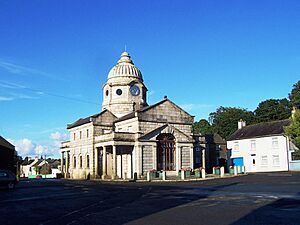Dunlavin Green executions facts for kids
Quick facts for kids Dunlavin Green executions |
|
|---|---|
| Location | Dunlavin, County Wicklow, Ireland |
| Date | 26 May 1798 |
|
Attack type
|
Firing squad |
| Deaths | 36 |
|
Non-fatal injuries
|
3 |
| Perpetrator | Irish Yeomanry |
The Dunlavin Green executions were a tragic event that happened in County Wicklow, Ireland in 1798. Thirty-six people, suspected of being part of a group called the United Irishmen, were quickly executed. This happened without a proper trial. The executions were carried out by a local army group known as the Irish Yeomanry. This event took place shortly after the start of the rebellion of 1798. Different stories about what happened were written down over time, and they sometimes have different details.
What Happened Before
Starting in 1796, the British government began forming local army groups in Ireland. These groups were called the yeomanry. They included both Catholic and Protestant members. Their job was to help protect Ireland from a possible French invasion. They also helped keep order in the country.
The United Irishmen had been planning a rebellion in Ireland for a long time. This rebellion finally began in late May 1798. The main uprisings happened in Ulster, Wicklow, and Wexford. Wexford is a county in the province of Leinster. For several months before May 1798, Wicklow and many other areas were under martial law. This meant the military was in charge to try and stop the rebellion from starting.
The fight against the United Irishmen even reached the military itself. Some yeomanry and militia groups, especially those with Catholic members, were suspected. People thought United Irishmen had joined these groups. They might have joined to get training and weapons.
A few days after the rebellion started, the yeomanry and militia in Dunlavin were called for a parade. Their commanding officer told them he knew who among them were United Irishmen. The officer actually didn't have this information. But twenty-eight men believed his trick. They came forward hoping to be treated kindly.
These twenty-eight men were immediately arrested and put in prison. Some of them were harshly questioned. This was done to try and get information about the United Irishmen's plans. Those who were identified as United Irishmen were held in the Market House in Dunlavin. Their officers then had to decide what to do with them.
The Executions
The next day, Captain William Ryves was on patrol. He was a leader of the Rathsallagh yeomanry. Rebels shot his horse from under him. Captain Ryves rode to Dunlavin the day after that. He brought eight suspected rebels who his group had captured. There, he met Captain Saunders of the Saunders-grove yeomanry. They decided that all their prisoners, a total of 36 men, should be executed quickly.
On May 26th, which was Market Day, the 36 men were taken to the green. They were lined up and shot in front of the townspeople. In some cases, their own families were watching.
After the shooting, the soldiers went back to the Market House. Other prisoners there were punished or taken away. Before the bodies of the shot men were removed, soldiers' wives took their valuable items. One wounded man protested, but a soldier finished him off. The families either took the bodies for burial. Or they were buried together in a large pit at Tournant cemetery. One man survived, even though he was badly hurt. He lived to be very old. Two more men, who were about to be taken away, were saved. A respected Protestant person helped them escape.
There is another story from a person who supported the government. This story tells about the events leading up to the executions differently.
In this account, Captain Ryves, a yeomanry leader in Dunlavin, heard that many rebels were going to attack Dunlavin. He also saw that many Protestant houses in the area had been set on fire. Because of this, he believed the rebels wanted to attack Protestants and government supporters in the town. The troops tried to go into the countryside but failed. The officers knew they had more prisoners than soldiers.
Remembering the Event
The story of Dunlavin Green was quickly remembered in a famous song. This song is called "Dunlavin Green." It tells the story from the point of view of a local person who felt sympathy for the victims. In 1998, a special stone was placed. It is in St Nicholas of Myra Roman Catholic church, which is next to the green.
See also


